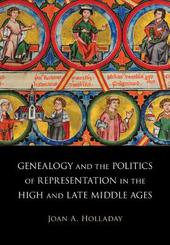
|
Genealogy and the Politics of Representation in the High and Late Middle Ages
Hardback
Main Details
| Title |
Genealogy and the Politics of Representation in the High and Late Middle Ages
|
| Authors and Contributors |
By (author) Joan A. Holladay
|
| Physical Properties |
| Format:Hardback | | Pages:406 | | Dimensions(mm): Height 261,Width 186 |
|
| Category/Genre | Byzantine and medieval art c 500 CE to c 1400
Genealogy, heraldry, names and honours |
|---|
| ISBN/Barcode |
9781108470186
|
| Classifications | Dewey:709.02 |
|---|
| Audience | | Professional & Vocational | |
|---|
| Illustrations |
Worked examples or Exercises; 11 Plates, color; 143 Halftones, black and white
|
|
Publishing Details |
| Publisher |
Cambridge University Press
|
| Imprint |
Cambridge University Press
|
| Publication Date |
17 January 2019 |
| Publication Country |
United Kingdom
|
Description
Images and image cycles with genealogical content were everywhere in the high and later Middle Ages. They represent families related by blood as well as successive office holders and appear as family trees and lineages of single figures in manuscripts, on walls and in stained glass, and in sculpture and metalwork. Yet art historians have hardly remarked on the frequency of these images. Considering the physical contexts and functions of these works alongside the goals of their patrons, this volume examines groups of figural genealogies ranging across northern Europe and dating from the mid-twelfth to the mid-fourteenth century. Joan A. Holladay considers how they were used to legitimize rulers and support their political and territorial goals, to reinforce archbishops' rights to crown kings, to cement relationships between families of founders and their monastic foundations, and to commemorate the dead. The flexibility and legibility of this genre was key to its widespread use.
Author Biography
Joan A. Holladay is Professor of Art History at the University of Texas, Austin. Author of Illuminating the Epic: The Kassel Willehalm Codex and the Landgraves of Hesse in the Early Fourteenth Century (1997) and Co-Editor of Gothic Sculpture in America, volume 3 (2016), she has held positions as Visiting Senior Fellow at Center for Advanced Study in the Visual Arts (CASVA), National Gallery of Art; Hohenberg Chair of Excellence, University of Memphis; and NEH Professor of the Humanities, Colgate University. In 2008, she received the Distinguished Teaching Award of the University of Texas's College of Fine Arts.
Reviews'The thesis of this work is that political positioning of medieval patrons, using both real and imagined lineages, was widespread ... Recommended.' K. E. Staab, Choice
|